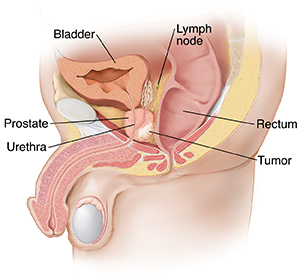Prostate Cancer
Hearing you have prostate cancer can be distressing. Thankfully, advances in early detection and treatment have greatly reduced the risk of life-changing side effects. Our goal is to treat the cancer while helping you preserve function and maintain your best quality of life.
What is Prostate Cancer?
Cancer starts when cells in the body change and grow out of control. Cancer cells can form lumps of tissue called tumors. Cancer that starts in the cells of the prostate is called prostate cancer. It can grow and spread beyond the prostate. Cancer that spreads is harder to treat.
Understanding the prostate
The prostate is a gland in men about the size and shape of a walnut behind the base of the penis. It wraps around the upper part of the urethra. This is the tube that carries urine from the bladder through the penis and out of the body. The prostate makes some of the fluid that’s part of semen. During orgasm, semen comes out of the body through the urethra.
When prostate cancer forms
As a man ages, the cells of his prostate often grow bigger. Most older men notice a change in their urine flow related to an enlarging prostate.
- Noncancerous (not cancer). As a man ages, the prostate tends to get bigger. This is called benign prostatic hyperplasia (BPH). With BPH, the extra prostate tissue often squeezes the urethra, causing symptoms, such as trouble passing urine. But BPH is not cancer, and it doesn't lead to cancer.
- Atypical cells. Sometimes prostate cells don’t look like normal (typical) prostate cells. One type of abnormal growth is called prostatic intraepithelial neoplasia or PIN. PIN cells are not cancer cells. But if the pattern of cells is very abnormal (called high-grade PIN), there's about a 1 in 5 chance that there might be cancer in another part of the prostate, or on a future biopsy.
- Cancer. A diagnosis of prostate cancer needs a biopsy of the prostate. A pathologist looks at the biopsy sample under a microscope. If the tissue structure looks disorganized and the prostate cells look abnormal, the pathologist may diagnose prostate cancer. If the prostate cells have invaded other tissues, they're called cancer cells. Some tumors can be felt during a physical exam, but depending on location, some cannot. Over time, prostate cancer may grow into nearby organs or spread to nearby lymph nodes. Lymph nodes are small organs around the body that are part of the immune system. In some cases, the cancer spreads to bones or organs in distant parts of the body. This is called metastasis.
Diagnosing prostate cancer
Prostate cancer may not cause symptoms at first. Urinary problems are often not a sign of cancer, but of another condition, such as BPH. If your healthcare provider thinks you may have prostate cancer, they will ask about your symptoms, health history, and family history. They may do a digital rectal exam to feel for lumps. Other common tests include:
- Prostate specific antigen (PSA) testing. This is a blood test. PSA is a chemical made by prostate cells. The amount of PSA in the blood (PSA level) can be tested to check for prostate cancer. In general, a high or rising PSA level may mean there's cancer. What is considered a normal PSA increases with age.
- Core needle biopsy. This test is needed to know for sure if a man has prostate cancer. A hollow needle is used to take tiny pieces of tissue from the prostate. During the test, a small probe is put into the rectum. The probe sends an image of the prostate to a video screen. With this image as a guide, the healthcare provider uses a thin, hollow needle to remove tissue samples from all over the prostate. These are sent to a lab where they are looked at and tested for cancer cells.
Ask your healthcare provider what tests you will need and what to expect.
Making a Treatment Plan
Being told that you have cancer can be scary. But it's important to know that most people who have prostate cancer don't die from it. Even when prostate cancer can't be cured, treatment can often keep it under control.
Your care team will talk with you about your treatment plan. This plan depends on many things, such as how much cancer there is and where it is. The plan depends on your age, your overall health, and your preferences. Talk with your care team about your options. Then you can make the decision that's best for you.
Your care team
Many health care providers will be part of your treatment team. You may work with these providers:
- Urologist. This is a provider who treats and does surgery on the urinary system and the male reproductive system.
- Radiation oncologist. This is a provider who treats cancer with radiation.
- Medical oncologist. This is a provider who treats cancer with medicines.
- Nurse practitioner or physician assistant. This is a person who may give you exams and manage your follow-up care.
- Your primary health care provider. This person refers you to the right specialists. They also watch your general health and any other health problems you might have.
You'll have other people involved in your care, such as:
- Nurses.
- Dietitians.
- Radiation therapists.
- Certified nursing assistants.
- Social workers.
You and your friends and family will be an important part of the treatment team. You'll all work together so you get the best care possible.
Choosing the best treatment
Your treatment options are based on:
- How fast the cancer is growing (the grade).
- How far it has spread (the stage).
- Your overall health and quality of life.
- Your life expectancy.
- Your urinary and sexual function.
- Your feelings about the side effects of each treatment.
- Other medical conditions you have.
Your treatment choices may include:
- Active surveillance. You may not need treatment right away. But your care team will watch you closely. You'll have regular follow-up exams, blood tests, or biopsies. Treatment can be started later if the cancer starts to get worse.
- Treating to cure. If the cancer is found at an early stage (when it's small and only in the prostate), the chance of full recovery is good. Early-stage cancer can often be cured by removing it with surgery. Or radiation can be used to kill the cancer cells.
- Treating to control. Late-stage cancer that has spread to other parts of the body often can’t be cured. But it may be controlled to slow growth and help you live longer and feel as well as you can. Methods for control might include surgery, radiation therapy, hormone therapy, vaccine therapy, chemotherapy, and targeted therapy.
New treatment options
Researchers are finding new ways to treat prostate cancer. These are tested in clinical trials. Taking part in a clinical trial may help you get the best treatment available today. You may get new treatments that are thought to be even better. Before starting treatment, talk with your health care provider. Ask if there are any clinical trials you should think about.

